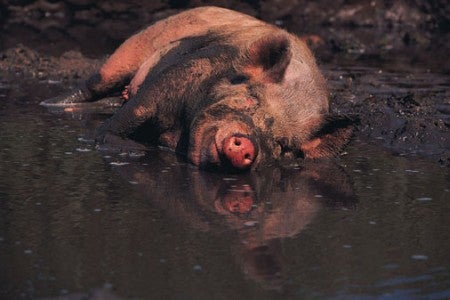The Benefits of a Pig Wallow
A typical behavior for which pigs are well-known is wallowing in mud. Whether it is in books, on TV, or in movies, pigs are frequently depicted wallowing because that is what comes natural to a pig. The relationship between pigs and mud runs deep, but just what is it about mud that a pig loves so much?
In the event that pigs are part of your farm operation, it is imperative that you understand their behaviors as well as their basic needs, one of which is access to mud. There are many reasons for pigs to wallow with the chief reason being temperature regulation. Since pigs have a minimal number of sweat glands, they cannot control their body temperature through perspiration like other species do. Being able to submerse themselves in mud is useful to a pig because mud dries slowly on their skin, allowing for longer moisture retention than if water alone were used to cool pigs. This helps a pig to stay cooler for a longer period of time. Alternately, however, pigs also wallow during cold temperatures to provide themselves with an insulated layer to help retain body heat.
Other services mud provides include protection against harmful UV rays that can burn pig skin. In much the same way that mud blocks sunlight, it protects against insect bites as well. Pests such as mosquitoes and biting flies have difficulty biting through the layer of moist dirt on a muddy pig as opposed to a clean one. Additionally, mud stops other types of parasites by acting as a suffocating barrier that makes sustaining life difficult or even impossible. Ticks and lice, for example, cannot breathe beneath a layer of mud and therefore cannot survive when such an environment is present on the bodies of pigs.
Along with the health benefits of wallowing, a link has been established between this behavior and the assertion of territorial dominance. Both domestic and feral pigs have been known to mark their wallowing holes to make their presence known and establish a territorial foothold. This is done through the application of their scent in a wallowing area via glandular release.
Over the years, farming has changed exponentially, taking animals away from what was once a thriving, natural environment and raising them in new, more efficient ways. In order to breed and raise more animals quicker and on smaller land parcels, pigs have been taken out of the wallow and placed in air conditioned barns where they are treated with medicines to combat and cure issues the mud once took care of all on its own. Though this may have advantages from the human perspective, the ability of a pig to thrive in such an environment may be lesser than in its natural world. Even if the physical welfare of pigs confined to barns remains the same, the mental welfare remains at question as pigs are denied the ability to act on their instincts and behave as they were designed to do.
Though it is up to each individual farmer the type of environment they wish to provide for pigs, it is worthwhile to consider the benefits of a natural wallow. The pig, after all, is not the only animal to wallow; it joins animal such as deer, rhinos, and elephants who are also known to act on such impulses. With various species getting in on the wallowing fun, surely this is one matter on which the pig cannot be wrong.









 Your Privacy Choices
Your Privacy Choices
Leave a comment